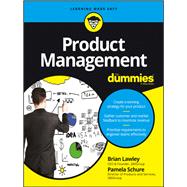Product management plays a pivotal role in organizations. In fact, it's now considered the fourth most important title in corporate America—yet only a tiny fraction of product managers have been trained for this vital position. If you're one of the hundreds of thousands of people who hold this essential job—or simply aspire to break into a new role—Product Management For Dummies gives you the tools to increase your skill level and manage products like a pro.
From defining what product management is—and isn't—to exploring the rising importance of product management in the corporate world, this friendly and accessible guide quickly gets you up to speed on everything it takes to thrive in this growing field. It offers plain-English explanations of the product life cycle, market research, competitive analysis, market and pricing strategy, product roadmaps, the people skills it takes to effectively influence and negotiate, and so much more.
- Create a winning strategy for your product
- Gather and analyze customer and market feedback
- Prioritize and convey requirements to engineering teams effectively
- Maximize revenues and profitability
Product managers are responsible for so much more than meets the eye—and this friendly, authoritative guide lifts the curtain on what it takes to succeed.








